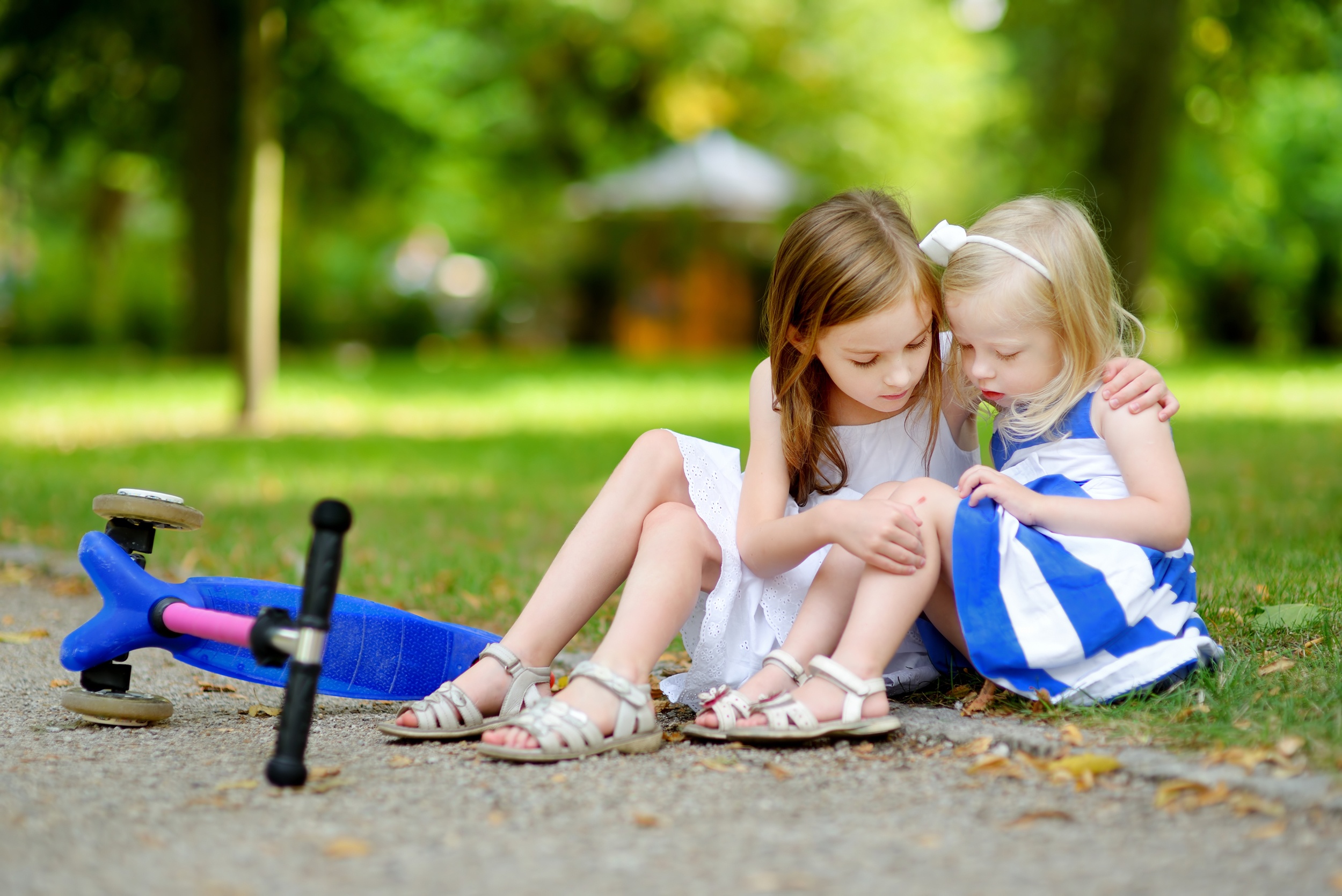 All parents want their children to show remorse and concern for others when an incident occurs. Check out these 6 simple steps on how to respond when your child hurts another.]]>
All parents want their children to show remorse and concern for others when an incident occurs. Check out these 6 simple steps on how to respond when your child hurts another.]]>
All parents want their children to show remorse and concern for others when an incident occurs. How does empathy grow? Does forcing an apology help to raise an empathetic child? Where should the motivation to feel sorrow, remorse, or concern for possible injury come from? Check out these 6 simple steps on how to respond when your child hurts another:
- Focus on the hurt child first: Go to the hurt child first and focus the attention on caring for them and making sure they are ok.
“Oh no, you got knocked over, are you ok? Are you hurt anywhere on your body?”
- Model empathy with your actions and words: As you comfort the other child and make sure they are ok; your child will likely be observing your behavior as you model care and empathy for others who are in need.
“I’m so sorry you were knocked down, that must’ve been a big surprise.”
- Talk to your child about how the other child was affected: Once the other child has been cared for and soothed, talk to your child about the incident and how their actions impacted another.
“You were running and knocked your friend over; he was crying because that scared him.”
- Ask your child for ideas to help make amends with the hurt child: Depending on the age of your child, they may need some help coming up with ideas on ways that they can help.
“Do you think your friend would like to play with this toy? How can we support him in feeling better, maybe they need a drink of water?”
- Help carry out the plan: Because the idea came from within her (intrinsic motivation) she gains the hands-on experience of true empathy. This experiential learning will eventually build empathy that becomes a part of her lifelong character.
- Find opportunities to talk about it later: Once the situation has past and emotions have cooled, find a way to talk about how the situation could be avoided next time.
“I was thinking about how you helped that little guy at the park this morning after you knocked him down. I wonder how we can try to keep that from happening again. Do you have any ideas?”
Children do not develop the ability to understand that other people have thoughts and feelings different from their own until around 4-5 years of age. Young children’s brains are wired to believe that the world revolves around them (in many cases, it does!). During the toddler years, kids need adults to help them learn how to respond in social situations because they don’t yet understand that other people may feel differently than they do.
Remember that teaching a child when to apologize and how to make amends is a gradual process. Insisting that your child apologize can easily become a power struggle, instead, consider the age and stage of your little one and have faith that with a little patience and time, they will learn to take responsibility for their mistakes, show remorse, and make authentic apologies.
 Positive discipline is a way of teaching and guiding children by letting them know what behavior is acceptable in a way that is firm, yet kind. At Forty Carrots Family Center, we love sharing ideas to help support our families on the journey of parenting and raising children, so we created “The Parenting Toolbox.”]]>
Positive discipline is a way of teaching and guiding children by letting them know what behavior is acceptable in a way that is firm, yet kind. At Forty Carrots Family Center, we love sharing ideas to help support our families on the journey of parenting and raising children, so we created “The Parenting Toolbox.”]]>
“Punishment” describes methods of gaining control by requiring rules or orders be obeyed and punishing undesired behavior. “Discipline” comes from the Latin root word disciplina, which means “giving instruction, to teach.” Recent brain research has confirmed that people learn best when they feel safe and connected to others, within the context of safe relationships. Positive discipline does not rely on rewards and punishments and instead uses the power of active listening, relationship building and working to understand your child through empathy and validation to promote positive behaviors.
The most powerful tool for teaching children is modeling what we want them to do or to be. Positive discipline is a parenting model based on the idea that there are no bad children, just good and bad behaviors. Connection must come before correction for discipline to be effective in the long term because the goal of positive discipline is to teach by first creating safe relationships with children.
At Forty Carrots Family Center, we love sharing ideas to help support our families on the journey of parenting and raising children, so we created “The Parenting Toolbox.” This toolbox is meant to help promote cooperation within the context of a safe relationship while also limiting power struggles with your little one.
- Be clear about expectations: THE RULE IS…
“The rule is…shoes on to play outside.”
- Promote cooperation: WHEN…THEN…
“When your shoes are one, then we’ll go outside.”
- Avoid power struggles: CHOICES…
“You can put your shoes on and play outside or stay barefoot and play inside. Which do you choose?”
- Communicate what is O.K. and remind them what is not: 3 PART REMINDER
- What you can’t do You can’t play outside without your shoes on.
- Why not? Your feet could get hurt.
- What to do instead You can wear shoes and play outside or stay inside and play without shoes on.
- OFFER SPECIFIC PRAISE
“Yay! Thank you for putting your shoes on! Now you’re ready to play outside. Let’s go!”
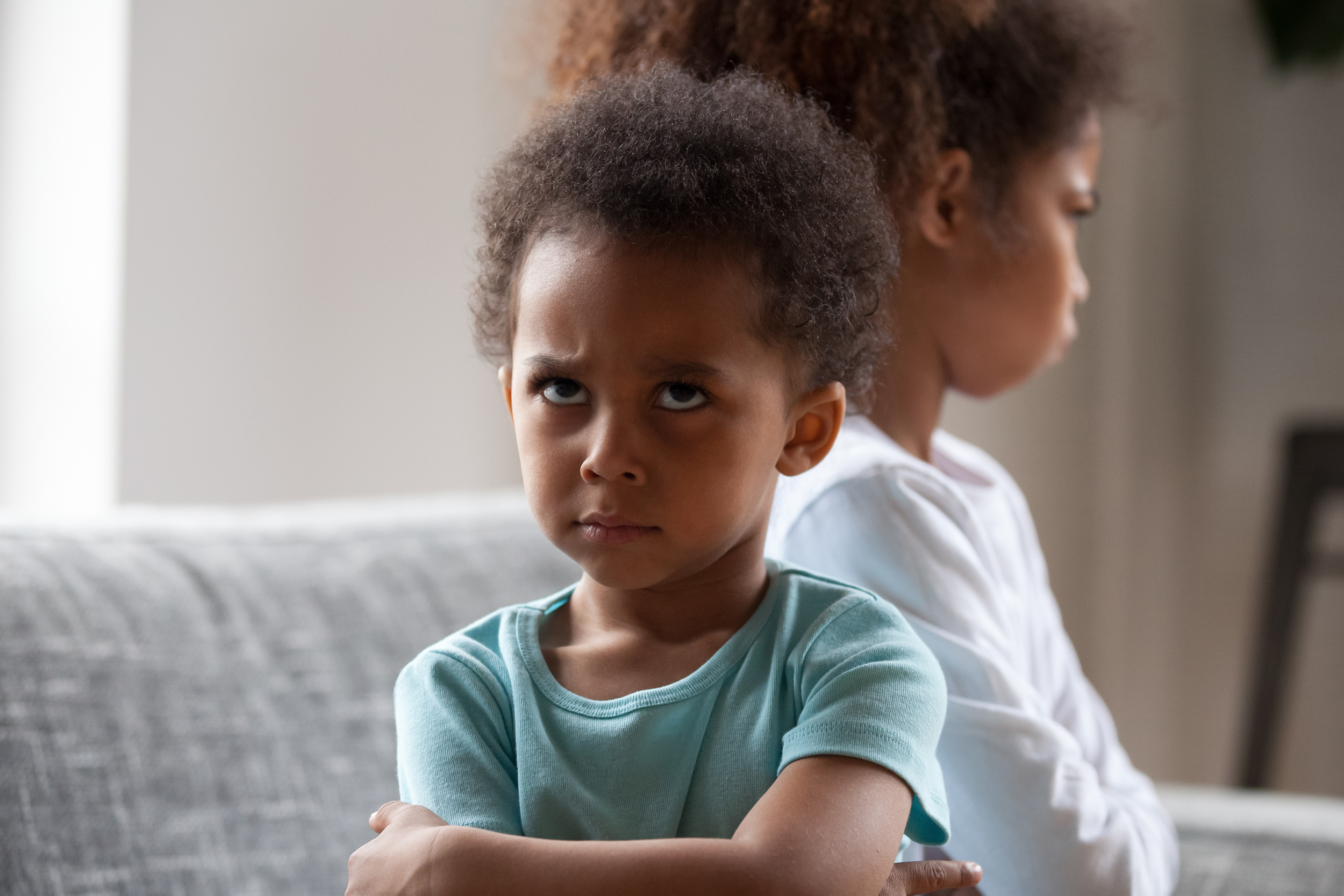 Are you noticing your kids having big feelings more often and the fights escalating? Although frustrating, the good news is that it is completely normal.]]>
Are you noticing your kids having big feelings more often and the fights escalating? Although frustrating, the good news is that it is completely normal.]]>
Sibling rivalry. It can challenge even the best of us. We all just want our kids to get along, but the fact of the matter is that siblings fight. It is just part of the business of growing up and figuring out how relationships work. Home is the training grounds for children to test boundaries, find confidence and gain an understanding of relationship dynamics.
The cause of sibling fighting is usually simpler than you may think, and it is a good idea to start with the basics. Children often fight because they are hungry, tired, bored, want attention, need alone time, or they just do not have the skills yet to communicate their feelings.
Just because it is a normal part of growing up does not mean you have to be driven crazy by sibling conflicts. For caregivers, it is our responsibility to give our children the tools with which to navigate these relationships. Here are a few tips to help establish more peace in your home:
- Be Candid. Talk to your children about how important their relationship with one another is to you. Be candid about the benefits of having a sibling as a lifelong friend.
- Validate ALL Feelings. Each sibling has a role when it comes to arguments, so be objective without blame. Try “You two seem to be having a hard time – I wonder what we can do,” instead of “who started this.”
- Be Calm. Be respectful in your communication and use discipline as a teaching tool. Focus on possible solutions and mutual agreements instead of punishments. This can help strengthen connection, the ability to cooperate, and create a positive sense of self.
- Model Empathy. Put focus on understanding unmet needs and boundaries. Try not to focus on the behavior that was hurtful. Instead talk about how it made them feel. Children generally know that hitting or hurting a sibling is not ok.
- Be Intentional. Make sure you are filling each individual child’s cup with one-on-one attention directed to their specific interests and needs. Let them know that they are safe, important, and loved, and that their needs will be met.
- Take a Time In. Allow everyone some time to calm down if things are still escalated. Stay nearby and offer support but do not try to force problem solving until everyone is ready to listen.
Keep in mind that the skills needed to manage and resolve conflict do not happen overnight. By investing in today, you are giving your child what they need so that eventually they will be able to manage their own relationship dynamics.
Some of the most important things we can show our children are patience and empathy. We all want our children to develop supportive and loving relationships with their siblings because we know how valuable that is. So, use the time when they are interacting well together to notice it and give specific praise to acknowledge how they are getting along. Be calm and understanding when they are having a hard time and fighting erupts. Before reacting, consider all the circumstances and remember that behaviors are a child’s way of communicating a need.
Generously offer grace. We are all struggling with a little extra anxiety right now and your child’s behavior may be coming from a place less obvious; they may be feeling more insecure and confused with the disruption of their usual routines, but without the capability to communicate that.
 Emotions are a normal part of life. Every emotion plays an important role in our lives, even anger, which can be one of the more difficult feelings to process. For children, behavior is communication which makes them more prone to acting out when they are angry. ]]>
Emotions are a normal part of life. Every emotion plays an important role in our lives, even anger, which can be one of the more difficult feelings to process. For children, behavior is communication which makes them more prone to acting out when they are angry. ]]>
Emotions are a normal part of life. Every emotion plays an important role in our lives, even anger, which can be one of the more difficult feelings to process. Anger and explosive behaviors are a coping mechanism to help alleviate the feelings of powerlessness and to numb feelings of sadness, pain, fear, hurt or disappointment, that have become overwhelming.
As adults, we understand that emotions are complex, but for children, this complexity of big feelings can feel overwhelming. Childhood expression of feeling overwhelmed and frustrated is different than adults because children lack the language to process those complicated emotions. Often, it is expressed through outbursts, tantrums, and difficulty calming down. Although these behaviors can be challenging for caregivers, it is helpful to understand that these responses to big emotions are a normal part of your child’s learning experience in identifying and expressing their feelings.
For children, behavior is communication. They don’t yet have the skill of impulse control, self-regulation, or the ability to effectively communicate (or even understand) what they are feeling. Because of this, kids are even more prone to lashing out when they are angry. As adults, it is our job to help give children language to their feelings and to accept their emotions (but not always the behavior), even the big ones.
Here are a few tips to help support your child in learning better ways to express their feelings:
Be Empathetic: When parents accept and empathize with their child’s feelings, it teaches them that emotions are normal. One of the best ways to build connection is through empathy, as it strengthens your relationship with your child, helps you understand them better, and helps them feel understood. “It is so frustrating when your sister takes your things without asking.”
Stay Calm: Staying calm when a child is upset, gives them a safe space to learn the emotional skills to calm themselves down and communicate their feelings. Children learn from watching how adults handle disappointment and conflict. Model for your child the calm you want to see in them.
Accept ALL Feelings: This is not giving permission for bad behavior, but rather letting your child know that the feeling is ok. So, listen and acknowledge their emotion. You don’t have to agree with why your child is upset to accept that he IS upset. By allowing and accepting emotions, you are giving your child more control over them instead of trying to hide them. Use this opportunity to name the emotion in order to build your child’s emotional vocabulary. Remember, all emotions are acceptable, however, certain behaviors are not. “You are so upset and that’s ok, you can be as mad as you want, but I won’t let you hit me (or your sister).”
Focus on the Positives: Praise the effort when you catch your child making good choices in how they respond to anger or big emotions. Let them know that trying to talk about how they are feeling or calming down on their own is the right choice, even if they don’t get it exactly right. Listen and empathize with however they express their feelings.
Coping Skills for Anger: Once anger sets in, it is harder to change the momentum, so learn the warning signs and help your child notice when they are getting upset or triggered. Sit with your child and create a list of things that can help when things start to escalate, and feelings are overwhelming. Try some of these ideas:
- Teach the benefits of 4/8 breathing; breathe in through the nose for four counts, and then out through the mouth for eight.
- Use stress balls; squeeze the anger out while breathing.
- Try music to change the mood or just “angry dance” the feelings out.
- Let them stomp or scream into a pillow. It can be triggering for parents, but these are safe alternatives to being physical toward another person or thing.
- Use routines. Children feel safer when they know what to expect.
- Older children can try drawing or journaling about their anger. Never criticize or judge their work if they choose to share it with you. It can be a good opportunity to create connection and build trust. “You used a lot of bold colors; can you tell me more about what you drew?” Or just allow them to rip it or crumple it up when they are finished.
Connection: Try to spend some time each day being present with your child. Take the time to give them your attention and to do things together, and don’t forget to make time for silliness and laughing. Children who feel better, do better. Remember, you aren’t trying to take away the big feelings or minimize your child’s emotions. Children need to feel safe and accepted, regardless of their feelings. Supporting and allowing a child to process their overwhelming emotions, helps them learn to self-regulate and express themselves in a healthy, productive way.
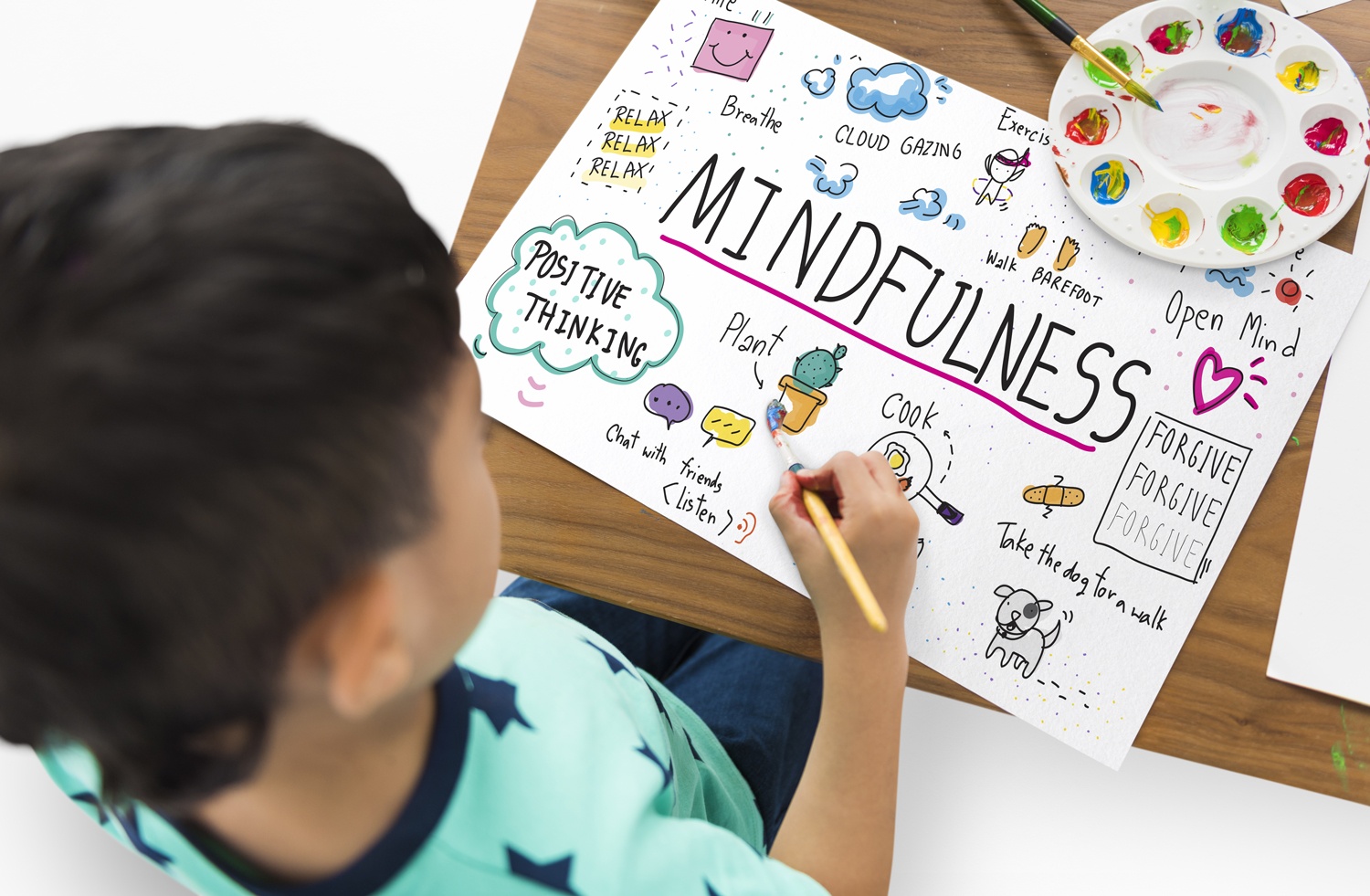 Mindfulness is about being present in the moment. Research shows that teaching mindful practices to young children can support stress reduction, self-regulation, levels of well-being and increase the capacity for compassion.]]>
Mindfulness is about being present in the moment. Research shows that teaching mindful practices to young children can support stress reduction, self-regulation, levels of well-being and increase the capacity for compassion.]]>
Mindfulness is about being present in the moment. This includes the awareness of one’s thoughts, feelings, and physical sensations. The goal of mindfulness is to become aware of your thoughts and feelings and accepting them, versus clearing your mind of all thoughts.
Research shows that teaching mindful practices to young children can support stress reduction, self-regulation, levels of well-being and increase the capacity for compassion. We already know that these activities make a difference with adults too. Mindfulness can improve emotional awareness, memory, and focus. This skill can also improve emotional awareness as well as reduce stress, anxiety, and depression.
Mindfulness is a state of mind rather than a particular action or exercise. However, as with most things, practice will improve your ability to be mindful. Try these simple ideas:
- Thoughts: Allow your thoughts to come and go, acknowledging them but not allowing them to control you. Think of this as a daily workout for your mind, so you are prepared to face the world without being overwhelmed.
- Breathing: Focus on intentional breathing and notice the physical sensations occurring when air is entering and leaving your lungs.
- Body Scan: Pay attention to the physical sensations throughout your body. Begin by focusing on your feet, noticing any sensations and move up through your body. Body scan and the five senses can be part of your everyday.
- Five Senses: The key is to focus on all your senses while observing your breath; accept your thoughts and let them go without judgment. Identify 5 things you see, 4 things you feel, 3 things you hear, 2 things you taste, and 1 thing you smell.
How can Mindfulness be a part of your everyday?
- During Transitions: Come up with five minutes a day to practice mindfulness. It could be a seated meditation first thing in the morning, before bedtime, or even while taking a shower. Practice it every day
- Mealtimes: Try mindful eating, notice, and discuss how the food looks, smells, the texture and taste.
- On The Go: Try playing the I Spy game to notice colors, shapes, letters, numbers, words, pictures, objects, etc.
- Take a Walk: Pay attention to how your body moves and feels with each step. Identify what you see, hear, smell.
Create “special playtime” with your child: Carve out five minutes a day, at least five days a week, to play mindfully with each child in your family. During this time, follow their lead! Use specific praise for things they do and try to avoid directing their play. While kids are naturally more mindful, this experience encourages them to keep at it while teaching us how to delight in them for who they are.
 Transitioning from one activity to another can be challenging, even for adults. Transitions are a natural part of daily life, but change can be especially challenging for kids.]]>
Transitioning from one activity to another can be challenging, even for adults. Transitions are a natural part of daily life, but change can be especially challenging for kids.]]>
Transitions are a natural part of daily life, but change can be especially challenging for kids. Whether it’s big changes like starting school or small ones like moving from one activity to the next, transitions are hard. Using strategies for transition can help prevent meltdowns and lower anxiety in children.
10 Transition Strategies for Kids:
- Be Aware of Timing: Look for a break in your child’s activity and use that as a natural time for transition. Example: wait until your child has finished an activity before telling them it’s time to eat. If you can be sensitive to what your child is doing, they will feel respected, and it can make transitions smoother for you both.
- Make It Visible: Use pictures if they aren’t reading yet. This helps a child know what they can expect and what is coming up next. It can be helpful to put the activities that your child struggles with closer to the beginning of the day when they are less tired.
- Set a Timer: Using a visual timer can help a child see exactly how much time they have left. Children do not have a concept of time, so saying “ten more minutes until we leave,” may not be very effective.
- Use a Special Object for Transitions: Sometimes, having a special blanket, doll, or stuffed animal can help ease transitions for children. When a child is transitioning from one place to another, such as from home to preschool, having a special “lovie” can be especially helpful. Consider including a small photo album or laminated pictures of close family to help support your child during these big transitions.
- Sing about it! Using a song during transitions is a great way to help kids move from one activity to the next. Kids love music. A familiar song can help them mentally prepare for the next activity or signal to them what time of day it is. You can make up your own silly song or use one that your child already knows.
- Keep Transitions Positive with Fun Activities: Whenever possible, try to make transitions fun. Example, “Let’s try hopping like bunnies to the dinner table!” or “Let’s count how many lights we see on the car ride home!”
- Don’t Rush: If you’re rushing, your child will pick up on your energy and may become even more stressed or frustrated. Don’t wait until the last minute to start the transition, give your child extra time to adjust; this can help limit meltdowns. If you are staying calm, it will help your child to stay calm.
- Give Choices When Possible: Choices can empower your child to feel part of the transition process. Example, “we have to leave in a few minutes. Which toy would you like to take with you in the car?” or “Do you want to walk to the car, or do you want to skip to the car?” Try to keep options limited and choose ones that are both acceptable.
- Be Consistent: As much as possible, try to stick with the schedule and routines that you have laid out. Routines are helpful with transitions that happen every day. Children can accept change better when they know what is coming.
- Be Patient: Remember that having to stop and transition to something else is hard for your child and that their disappointment is part of the natural process. This disappointment provides a wonderful opportunity to talk about emotions, and encourage the expression of their feelings, “I know you feel frustrated that we have to leave the park sooner than you’d like.”
Keep in mind that kids don’t have a lot of control over their lives. They often don’t get a say in what, where, when and how their day will unfold, and this can make it even more frustrating for them to have to quit something they are enjoying or transition to something new or unfamiliar.
One of the most difficult transition of the day for kids can be the one from home to school/preschool or the one from school back home. Remember that communication between you and your child as well as between you and the school/daycare is important in helping your child make these transitions as seamless as possible.
Always praise your child for handling transitions well. Let them know how good it is when you can work together as a team.
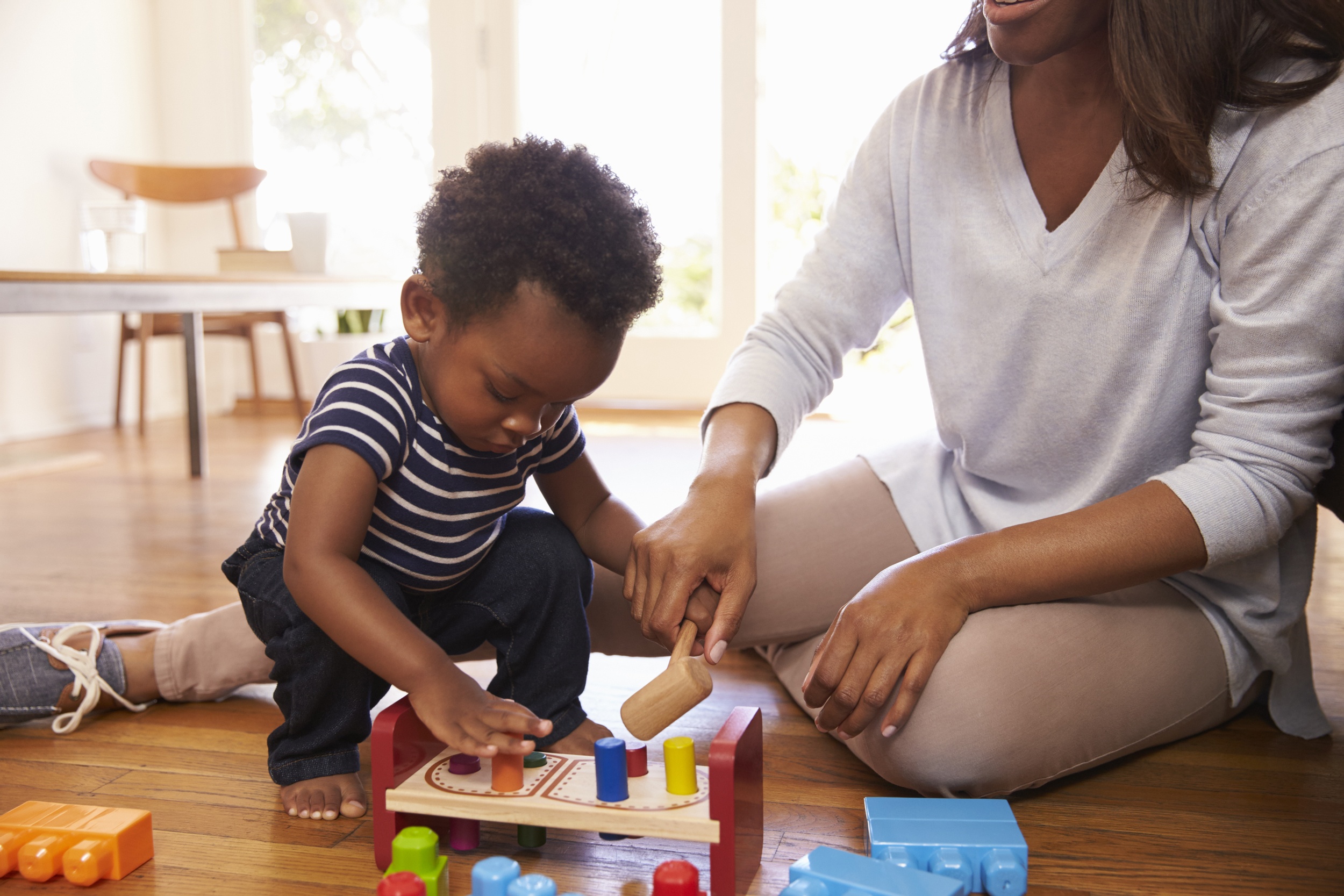 From a very early age, you may notice that your little one has their own characteristics and patterns of behavior that influence the way they respond to daily events in their life. This is called their temperament; it helps to shape your child’s world and as a result, yours too. ]]>
From a very early age, you may notice that your little one has their own characteristics and patterns of behavior that influence the way they respond to daily events in their life. This is called their temperament; it helps to shape your child’s world and as a result, yours too. ]]>
Have you ever noticed how some children are seemingly born calm and easygoing while others may be fussier or more easily upset? Some are shyer while others seem to be outgoing and social? It is no secret that every child is unique in almost every way. From a very early age, you may notice that your baby has their own characteristics and patterns of behavior that influence the way they respond to daily events in their life. This is called their temperament; it helps to shape your baby’s world and as a result, yours too.
Temperament is not something your child chooses, nor is it something that you created. Understanding and recognizing patterns in your child’s behavior that are influenced by temperament can help you anticipate your child’s responses to certain situations.
Generally, there are nine characteristics that describe temperament:
- Activity Level: How active the child is generally.
- –High activity level: Kids with high activity level tend to squirm and fidget and don’t like sitting still.
- –Low activity level: Kids with low activity level prefer quiet, calm activities.
- Distractibility: Degree of concentration and paying attention when not particularly interested.
- –High distractibility: Kids are easily distracted by noises and things they see; have trouble concentrating; very distracted by any small discomfort such as being hungry.
- –Low distractibility: Kids are able to concentrate on an activity without easily being distracted.
- Intensity: How loud the child is.
- –High intensity: Kids with high-intensity reactions tend to have very strong reactions–both positive and negative–to things.
- –Low intensity: Children with low-intensity reactions tend to have muted, less emotional reactions.
- Regularity: The predictability of biological functions like appetite and sleep.
- High regularity: Exhibiting regular and predictable eating, sleeping patterns.
- Low regularity: Exhibiting irregular eating, sleeping patterns.
- Sensory Threshold: How sensitive the child is to physical stimuli: touch, taste, smell, sound, light.
- High sensory threshold: These kids tend to be highly sensitive to sounds, tastes, smells, touch, and so on; they tend to be picky eaters and may be the kind of kids who refuse to wear anything that they think feels “scratchy,” even though most people wouldn’t feel the fabric as scratchy.
- Low sensory threshold: These kids aren’t sensitive to changes in textures, sights, and smells, and will be open to trying new foods; they aren’t sensitive to new surroundings and can fall asleep easily anywhere.
- Approach/Withdrawal: Characteristic responses of a child to a new situation or to strangers.
- High approachability: These kids happily welcome and approach new situations and people.
- Low approachability: These kids do not like new and unfamiliar people, places, and things.
- Adaptability: How easily the child adapts to changes like switching to a new activity.
- High adaptability: Kids handle transitions well and quickly adapt to changes in a situation.
- Low adaptability: Kids need more time to handle transitions and may cry and cling to mom, dad, or a caregiver when faced with a new situation.
- Attention span and Persistence: Stubbornness and inability to give up.
- High attention span and persistence: These kids do not get easily discouraged or frustrated even when there are obstacles; they keep trying.
- Low attention span and persistence: These kids give up when they face a roadblock and become easily frustrated.
- Mood: Reactions to the world primarily in a positive or negative way.
- Positive mood: Kids who have positive mood tend to be generally cheerful, pleasant, and friendly.
- Negative mood: Kids who have a mood that veers toward negative tend to be easily upset, withdrawn, and more prone to crying.
Temperament + Experiences = Personality
A child’s behavior and approach to the world are shaped by experiences and by the interactions with their primary caregivers; this becomes their personality. For example, a child who is shy can become more outgoing and adaptable in new situations when caregivers consider their temperament and allow them to slowly adapt to new experiences at their own pace.
Remember: There is No Right or Wrong Temperament
It’s very important for children to be accepted for who they are. Every child has a unique temperament, even within the same family, and some temperaments are easier than others to parent. Adapting your parenting to your child’s individual temperament will help nurture development and can help your child strengthen the positive parts of their temperament. Think about how your own temperament, personality or experience is affecting how you respond to your child. Try to give some thought to what’s behind your reactions and then try to remember that your child is an individual with her own temperament and traits, that are separate and unique from your own.
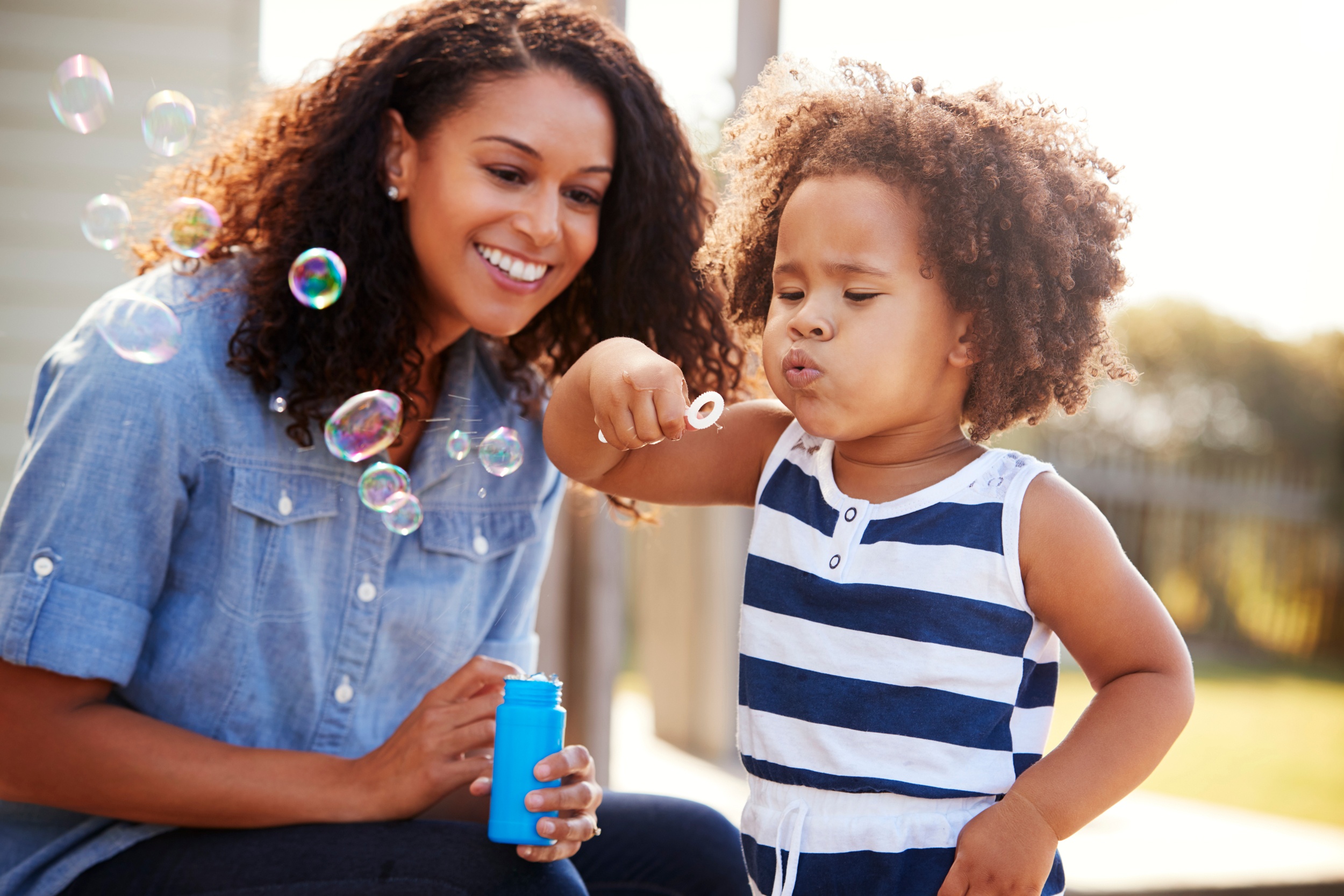 All children get upset from time to time, from someone snatching a favorite toy to having to leave a play date when they are having fun; anger is a natural reaction to a frustrating experience. ]]>
All children get upset from time to time, from someone snatching a favorite toy to having to leave a play date when they are having fun; anger is a natural reaction to a frustrating experience. ]]>
All children get upset from time to time, from someone snatching a favorite toy to having to leave a play date when they are having fun; anger is a natural reaction to a frustrating experience. As parents, we cannot prevent our children from ever encountering frustration, but we can help them learn how to cope and express these big feelings in a calmer way. Teaching them how to stay relaxed and calm in stressful situations at a young age can better prepare them for emotional success later in life.
Children start to learn self-regulation techniques early in life. Picking babies up and holding them when they are upset is the first step in teaching regulation. They learn that the world is a safe place, their caregivers will help them get their needs met and support their feelings. Try these everyday tips to support your little one in building self-regulation skills:
- Help your child identify the triggers. Young children don’t always know they are getting upset until it is a major melt down, so if you can help them identify the physical symptoms they are feeling (such as heart pounding, talking louder, or face getting hot) and what triggers them, they will have a better chance at recognizing their own feelings in the future.
- Share your feelings with your child. If someone cuts you off in traffic, you might let them know that it scared you. Waiting to see the doctor or in a long line is a good time to talk to your child about how frustrating waiting can be, and then use the opportunity to talk about what we can do to help us wait patiently.
- As a toddler, your child is learning to manage big feelings. Naming feelings is important in teaching your child to identify them and self-regulate. When toddlers are given words for feelings, they can eventually learn to recognize them, and eventually handle them. When you hold your infant and toddler and support them through tough feelings, you are building social emotional competence.
- Talk with your child about different ways to handle stressful situations. Deep breathing is a wonderful way to calm anger and it can be easily taught to young children. Taking a break is another way to remain calm in a stressful situation. Try the strategy yourself when you get angry, telling your child “Mommy is frustrated right now and needs a few minutes to calm down.”
One of the most important ways to teach your child to be calmer is to practice being calmer yourself. If you tend to raise your voice when angry, your child will likely do the same. Remember, calm is contagious—but so is stress. When we as parents are nervous, anxious, or easily angered it is more likely to increase these behaviors and reactions in our children. children learn self-regulation techniques through the way we parent and how we manage our feelings. Let’s strive to be the best role models we can be!
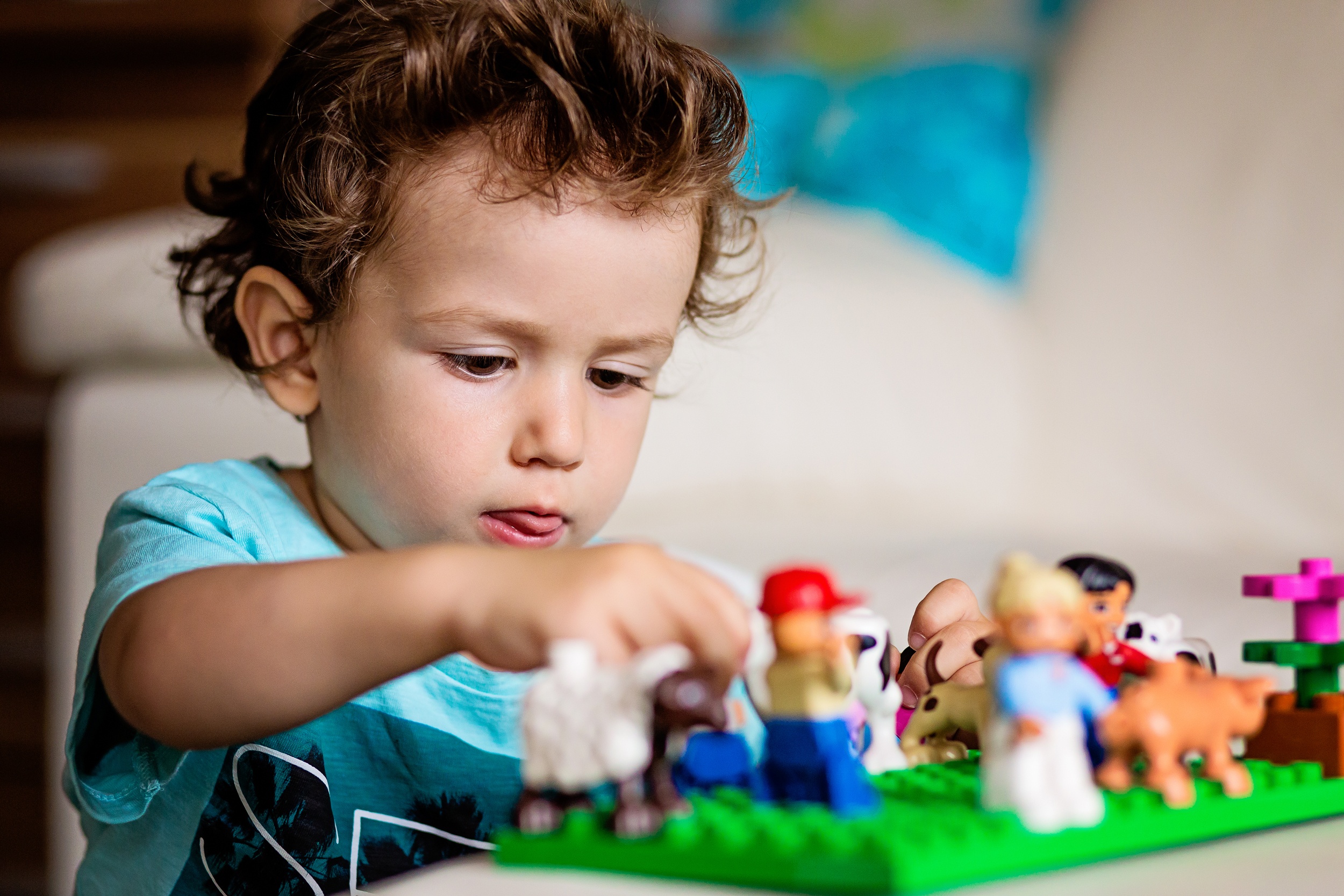 Promoting independence is an important part of parenting because it allows children to feel respected and capable. One of the best ways to encourage independence is through play.]]>
Promoting independence is an important part of parenting because it allows children to feel respected and capable. One of the best ways to encourage independence is through play.]]>
Even when young children love to assert their independence, they still desire your attention and company. After all, YOU are their first and favorite playmate. When they are building blocks, they want you to build blocks too. If you leave the room for a moment, they become your shadow and want to help you with whatever you are doing. This can be both sweet and frustrating! Below are some practical ways to encourage and strengthen your child’s ability to play independently so that you won’t be their sole source of entertainment.
- Use parallel play. This technique is helpful when you want to reassure your child that you are nearby while he plays independently. You could say, “While you build a tower over there, I’m going to work on this puzzle over here.” Eventually you will be able to play farther away or leave the room for short periods of time because your involvement will be less and less important. Play is such valuable time for children to learn, imagine, take chances, and make mistakes and then do-overs.
- Provide open-ended toys. Toys such as blocks, dress-up clothes, play food, small figurines (people or animals) and dolls can be played with over and over again in different ways. Recyclable objects such as cardboard boxes, paper towel rolls, and empty milk jugs make great toys as well!
- Make things new. Sometimes just changing things up a bit will renew your child’s interest in a toy or activity. Rotate toys by temporarily packing some up and bringing old toys out again. If you don’t have extra storage space, simply change the location of a few toys to bring new life to some old favorites.
- Teaching patience and resilience. Children eventually learn that their parents cannot always be at their beck-and-call. Knowing how to play independently and wait until someone is available to help them can teach children patience and give them the confidence to know that they can do things on their own.
Remember that engaging in uninterrupted play with your child for fifteen minutes each day will help “fill the meter,” making him more willing and able to play independently. Be sure to check out a Forty Carrots Partners in Play group for a perfect opportunity to connect with your little one and fill their emotional bucket.
 Are parents equipped with natural instincts and intuition? Parental instinct and intuition are often used interchangeably, but they are different. ]]>
Are parents equipped with natural instincts and intuition? Parental instinct and intuition are often used interchangeably, but they are different. ]]>
There is no research to prove parents have natural instincts. Parenting instinct refers to a biologically based, in-born knowledge of how-to parent. Examples of instinctual parenting can be found in nature with animals. Hover, human relationships are much more complex. Research shows that humans don’t have an in-born instinct of how-to parent. We base our parenting styles on a combination of our relationship with our children, our past childhood experiences, and our own research on parenting.
While we can’t be sure about instinct, research proves that intuition does exist. Intuition is based on inner thoughts and feelings, otherwise known as “gut feelings”. Decisions based on intuition often happen without weighing facts or logic, it’s just a feeling. Research states that there are four primary types of intuition. Check out how intuition can be relevant to parenting.
Problem-Solving Intuition: You are the expert of your child. All the time you spend with your child helps you learn and understand him in a way that no one else can. That learning and understanding gives you those “gut feelings”, the knowledge and expertise of how-to problem-solve during certain fast-paced, critical situations. It is likely that no other person could have the problem-solving intuition when it comes to your child.
Social Intuition: Based on experiences, adults understand verbal and non-verbal cues of how others are feeling. Social intuition is very helpful with little ones since they don’t have the life experience to advocate for themselves. Young children don’t have the maturity to understand how they feel, why they are behaving the way they are or how to vocalize their emotions. They don’t have the vocabulary or skill to tell us when they are overstimulated, overtired or just need a break. Parents can use social intuition to read cues that help to know when to set necessary limits that support their child’s needs.
Creative Intuition: Being able to “think outside the box” problem solve is creative intuition. You know your child best, so when there is a reoccurring problem such as bedtime struggles and you get a new “ah-ha” of what might work, that is following your creative intuition. Follow those “gut feelings” to trust yourself that you can support your child with a specific struggle by getting creative with possible solutions.
Moral Intuition: This kind of intuition focuses on following your emotions of what is right and wrong. You may have “gut feelings” regarding parenting decisions and what feels right or wrong to you. You can probably come up with reasons to justify a decision afterwards, but initially that moral intuition helped you decide what felt right for your child and you in the moment.
The more time we spend with our children the better we can hone into our parental intuition that can effectively meet their needs. Does this mean that parents should “listen to their gut” when parenting? YES! Finding a balance between using your intuition while also being informed when making decisions is the key.